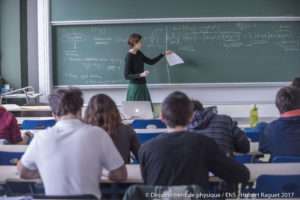Bruno Le Floch joined the Institute in autumn 2018 after a postdoc at Princeton University. He obtained his PhD from the École Normale Supérieure (Paris) in 2015 with research done partly in Perimeter Institute (Waterloo). He studies dynamics of gauge theories, especially through their extended operators and through string theory.
In [41,43,44,46,48] he has explored the beautiful AGT correspondence, which relates four-dimensional supersymmetric gauge theories (both at strong and at weak coupling) to two-dimensional conformal field theories, and he has enriched the correspondence with extended operators. In particular he found a microscopic description of intersections of M2 and M5 branes in M-theory [43,46].
An important technique to which he has contributed [42,45,46,47,48] is supersymmetric localization, which allows exact evaluation of some supersymmetric path integrals. His exact results on the two-dimensional sphere [42,45] have been used to deduce the Zamolodchikov metric on some spaces of two-dimensional conformal field theories, as well as extract previously unknown enumerative invariants of Calabi-Yau manifolds.
Likewise, the two-dimensional hemisphere partition function gives insight on D-branes (boundary conditions of the string worldsheet), which he used to work out brane transport in some models as Kähler structure parameters are varied [51].
In a separate line of work he has also proven the existence of solutions to Einstein and Euler equations for self-gravitating fluids for initial data that have shock-wave singularities, when this data have two-torus symmetry [49].










